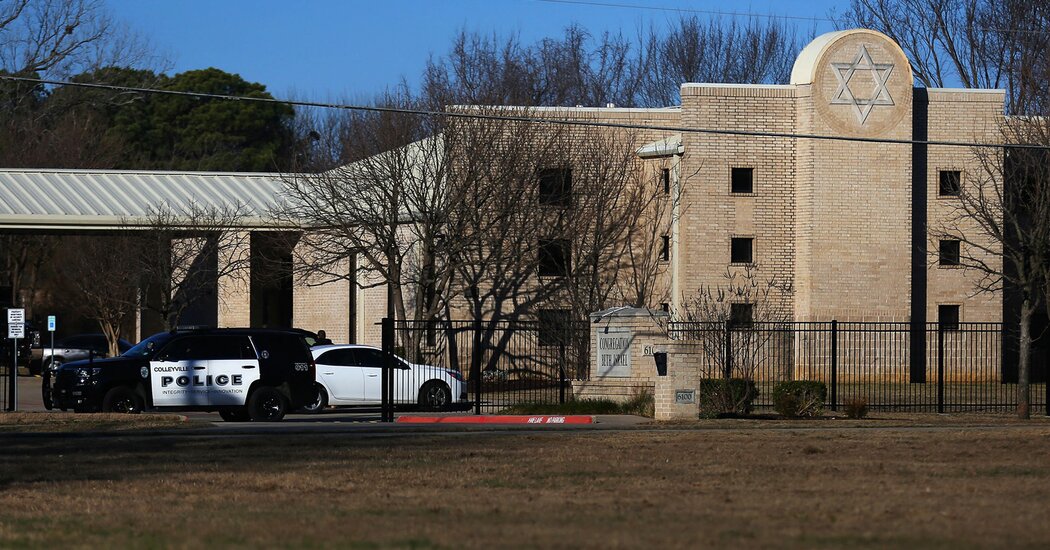Aafia Siddiqui has spent almost 12 years in a U.S. federal prison after being convicted of trying to kill American soldiers and plotting to blow up the Statue of Liberty.
KARACHI, Pakistan — A neuroscientist who was educated at the Massachusetts Institute of Technology, she was accused of trying to kill American soldiers and plotting to blow up the Statue of Liberty. Since then, Aafia Siddiqui has spent almost 12 years in a federal prison in Texas.
Now, investigators are looking into whether her story may have motivated the British attacker who stormed a Texas synagogue on Saturday and took four people hostage. Since Ms. Siddiqui’s conviction in 2010 for “terroristic events” in Afghanistan, her name has become a rallying cry among Islamists in her native Pakistan, and her defiance in the face of arrest has made her a hero to jihadist militants worldwide, experts said.
“Her rejection of mainstream life makes her an empowering example for the jihadi groups who exploit her victimhood,” said Abdul Basit, a research fellow at the S. Rajaratnam School of International Studies in Singapore.
The F.B.I. said on Sunday that the attacker, Malik Faisal Akram, spoke of Ms. Siddiqui’s case, which has been used as a pretext for previous terrorist attacks and has also garnered renewed focus since American forces withdrew from Afghanistan last summer. In October, hundreds of people marched to the U.S. Consulate in the port city of Karachi to demand that the Biden administration order her release.
Ms. Siddiqui, 49, is serving an 86-year sentence at the Federal Medical Center, Carswell, in Fort Worth, about 24 miles southwest of Congregation Beth Israel in Colleyville, Texas, where the 11-hour standoff ended on Saturday with the hostage-taker’s death.
Ms. Siddiqui, who attended M.I.T. and received a Ph.D. from Brandeis University, was taken into custody in Ghazni, Afghanistan, in 2008, after the local authorities became suspicious of her loitering outside the provincial governor’s compound.
American prosecutors said that at the time of her arrest she was carrying handwritten notes plotting a “mass casualty attack,” with a list of potential targets, including the Empire State Building, the Statue of Liberty, Wall Street and the Brooklyn Bridge. Other notes in her possession referred to the construction of “dirty bombs,” prosecutors said.
On July 18, 2008, while in custody in Afghanistan, Ms. Siddiqui grabbed an M4 rifle from a police station floor and fired on Army officers and F.B.I. agents, prosecutors said. She was shot in the abdomen.
During her 2010 trial at a federal court in New York, Ms. Siddiqui denied she had fired the rifle or knew how to make a dirty bomb. The trial was frequently interrupted by her anti-Semitic outbursts, including her demand that jurors be given genetic tests to determine who among them was Jewish.
The court proceedings became fodder for New York’s tabloids, which nicknamed her “Lady Qaeda.” But in Pakistan, the news media portrayed her as a victim of the injustices meted out to Muslims by the United States after the Sept. 11 attacks and called her trial a “farce.”
In 2010, Prime Minister Yousaf Raza Gilani, who had described Ms. Siddiqui as a “daughter of the nation,” joined Pakistan’s opposition leader, Nawaz Sharif, in promising to push for her release. Senators in the country passed a resolution to demand her return.
Ms. Siddiqui’s incarceration, combined with unsubstantiated reports that she had been sexually assaulted in prison, has become a rallying cry for jihadists around the world who have committed violence in her name.
Islamist militants from Pakistan, Afghanistan, Algeria and Syria have made Ms. Siddiqui’s release a condition for their freeing foreign hostages.
In 2014, the Islamic State proposed swapping the American journalist James Foley for Ms. Siddiqui. Mr. Foley was killed after the group’s demands, which also included an end to U.S. airstrikes in Iraq, were not fulfilled.
Similarly, Qaeda-linked militants, who took dozens of people hostage at a gas plant in Algeria in January 2013, offered to swap U.S. captives for two prisoners, including Ms. Siddiqui.
In March 2013, the Tehreek-e-Taliban Pakistan group carried out a suicide attack on the judicial complex in Peshawar, Pakistan. The terrorist outfit said the attack on the judiciary was for “its failure to protect innocent citizens like Ms. Siddiqui.”
In November 2018, the Pakistani Senate unanimously passed a resolution proclaiming her a “Daughter of the Nation” whose case needed to be taken up with the U.S. government urgently.
One of Prime Minister Imran Khan’s election promises in 2018 was to bring her home.
Qari Sadiq Farooqi, a madrasa student in Karachi who participated in the October protests, reacted to the hostage situation in Texas on Sunday with defiance.
“Ms. Siddiqui is innocent and a victim of the U.S.’s war against terror,” he said. “How can a woman snatch a gun from U.S. soldiers and attack them?”
But Ms. Siddiqui’s sister, Fowzia Siddiqui, said that the family wanted “no violence in Ms. Aafia Siddiqui’s name.”
“A growing and tragic result of Ms. Siddiqui’s continued detention is that our appeals to avoidance of violence are being ignored, as people lose faith in the efficacy of those means. Thus we see extremists exploiting this and expressing their anger in a deplorable manner,” she said.
Livia Albeck-Ripka contributed reporting.


























